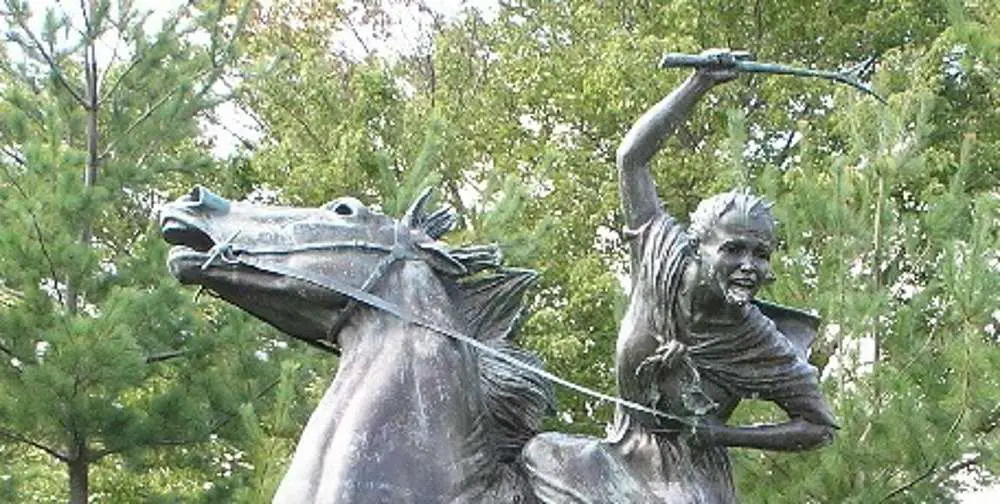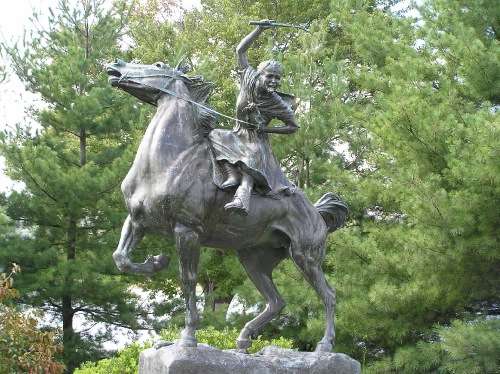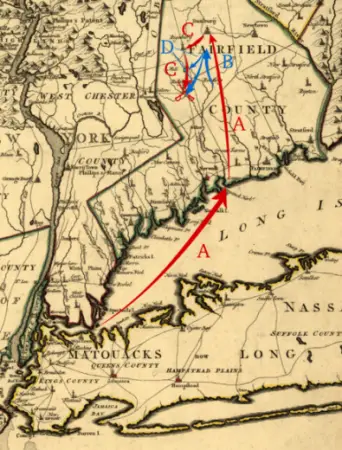Like Paul Revere, Sybil Ludington took a midnight ride to warn American patriots the redcoats were coming.
They were coming to Danbury, Conn., rather than Concord, Mass., and Sybil was half Revere’s age. She also rode twice as far.
Two years into the American Revolution there had been no fighting in Connecticut. There had been in New York, though, where Gen. William Tryon commanded 3,000 British forces. Meanwhile, Gen. William Howe prepared to attack the rebel capital of Philadelphia.
But then Tryon was ordered to attack the Americans’ supplies in Danbury, defended by about 150 American troops. So he assembled a fleet of ships to carry about 2,000 troops from New York to Connecticut.
Tryon set sail on April 22, 1777 and landed three days later in Fairfield, now Westport. Patriots spotted the British fleet as it sailed past Norwalk. Messengers then rode to alert the leaders of the patriot militia, including Col. Henry Ludington in Kent, N.Y.
Ludington commanded the Dutchess County, N.Y., militia, just over the border from Connecticut. He had the only forces between Tryon and Gen. George Washington’s army at Peekskill, N.Y.
Bad News
Late on April 26, a cold, wet, exhausted messenger arrived at the Ludington home to say the British were burning Danbury, about 20 miles away.
The British troops destroyed as many as 5,000 barrels of pork, beef, and flour, 5,000 pairs of shoes, 2,000 bushels of grain and 1,600 tents. They also got drunk on rum. The soldiers set fire to 19 patriot houses, a church, a blacksmith shop and a meetinghouse, but they spared the Tory houses. People could see the glow of the fire for miles.
“It was one of the most brutal and disgraceful performances of British arms in all the war, and was unhesitatingly denounced as such by self-respecting British officers,” according to a memoir of Henry Ludington.
Ludington’s men, however, had dispersed. It was planting season, and they were at home on their farms. The exhausted messenger couldn’t rouse them. And Henry Ludington needed to stay at home to muster his men.
Sybil Ludington
Sybil, the Ludingtons’ oldest child, volunteered. She had just turned 16 on April 5, she rode well and she knew where the militiamen lived.
Sybil Ludington set out at 9 pm and rode along the rugged and lonely roads through a thunderstorm, urging on her horse, Star, with a stick. She rode from Carmel to Mahopac to Stormville. “Gather at Ludington’s!” she cried. “The British are burning Danbury!”
A highwayman tried to stop her, but she fended him off with her stick.
At dawn, Sybil Ludington returned home after riding 40 miles. Her father’s 400 militiamen had assembled there, a motley group. Some were only half dressed and some didn’t have arms, but they were ‘filled with a certain berserk rage.’ Within an hour or two they marched to Connecticut.
By then, thousands of militiamen and Continental Army troops headed toward Danbury. Tryon had hoped his maneuver into Connecticut would inspire an uprising of Loyalist support, but he miscalculated badly. Realizing his peril, Tryon ordered his presumably hungover men to return to their ships in Westport.
Battle of Ridgefield
The British soldiers retraced their steps through Ridgefield, Conn., where Ludington’s militia met up with other militias and Continental troops. The British outnumbered the Americans three-to-one, and managed to push through barricades and march to their ships. But they suffered casualties, as the Americans shot at them from behind rocks and trees as they had after Concord and Lexington.
Tryon’s victory was Pyrrhic. Though he achieved his aims, he galvanized support for the patriot cause in Connecticut. Soon after his troops boarded the ships bound for New York, 3,000 men joined the Connecticut Army of Reserve. Later that year, Connecticut sent cavalry and two regiments to Saratoga, where they defeated forces led by British Gen. John Burgoyne.

Stamp issued on March 25, 1975
George Washington came to the Ludington home to thank Sybil Ludington for her heroic ride. In 1784, she married Edmond Ogden and they had one child, a son named Henry. Sybil Ludington died in Catskill, N.Y., on Feb. 26, 1839.
Today, historical markers trace the route of her ride. There are statues of her near Carmel, N.Y., on the grounds of the Daughters of the American Revolution in Washington, D.C., at the Danbury Library in Connecticut and at Brookgreen Gardens in South Carolina. In 1975, a U.S. postal stamp was issued in her honor. Every year since 1979, the 50-km Sybil Ludington road race has been run in Carmel, N.Y., finishing up near her statue.
This story about Sybil Ludington was updated in 2023.



4 comments
[…] the Battle of Ridgefield in 1777, British troops fired on the tavern because they learned people were melting down musket […]
[…] barricaded the center of Ridgefield. He received reinforcements from Col. Henry Ludington, whose 16-year-old daughter Sybil had raised them during a horseback ride twice as long a Paul Revere’s. The British drove them off in a running battle down Main Street, […]
[…] is twice as long as Paul Revere rode on his famous ride, and yet somehow he gets all the credit. Sybil also had to deal with a highwayman trying to attack her, but she managed to fend him off with … Ultimately, the young heroine was successful in rounding the troops but the troops weren’t […]
[…] This story about Isaac Bissell was updated in 2018. If you enjoyed reading it, you might also want to read about Sybil Ludington, the female Paul Revere, here. […]
Comments are closed.